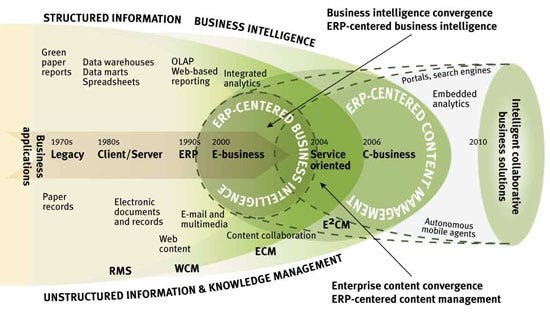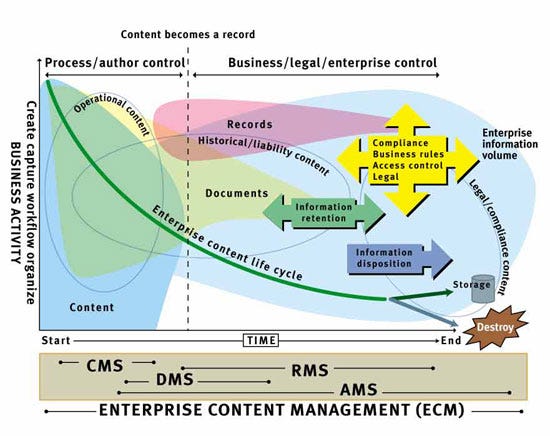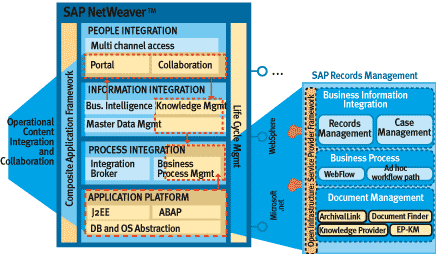ERP and Content Management: Harmonic Convergence?
To drive collaborative processes, businesses need embedded intelligence. BI, focused on structured data, is only half of the story: Businesses need content management for the unstructured stuff. ERP wants to be the point of convergence.

Not long ago, perhaps hundreds of data warehouse and business intelligence (BI) vendors filled the marketplace. Then along came the packaged enterprise resource planning (ERP) application vendors (such as Oracle, PeopleSoft, and SAP) to swallow much of the BI market by providing suites as part of their extended ERP business applications. Today, we're seeing this happen with the Web services paradigm.
Along with its offshoots — service-oriented architecture (SOA) and enterprise services bus model — Web services are hot, and again ERP vendors are converging on a new opportunity. As they evolve their proprietary platforms toward J2EE-centered, open business-application platforms, ERP vendors are kicking up a big struggle among leading application and integration server industry leaders, including BEA, IBM, and Microsoft.
Urgent business drivers are forcing stovepiped and proprietary applications providers to offer open, standards-based, services-oriented platforms that allow customers to adapt quickly to business change by managing, subscribing to, and collaborating with services rather the large-grained applications. Such flexibility and adaptability requires, first, a close and intimate understanding of the business rules that drive processes; and second, the intelligence to monitor key performance and process indicators so that the organization can act when something requires immediate attention.
To meet these evolving requirements, it was logical for ERP vendors to start by incorporating BI infrastructures, as SAP has with Business Information Warehouse (BW). The top part of Figure 1 shows the convergence of BI and ERP (and how it fits with other trends I'll discuss in this article). The turbulence in the traditional BI marketplace and among customers caused by the ERP thrust continues to be felt keenly. Starting from a standalone environment, BI vendors and their customers must first collect data and then integrate the "intelligence" back into the business processes to enable smarter decisions. This isn't easy for BI vendors or for their customers.

FIGURE 1 - Intelligent collaboration: enterprise content management convergence.
Reaching Out
Now, with ERP vendors marching down the SOA road, we're seeing them refashion their systems on top of open, J2EE-based platforms. Initial Web-enablement attempts weren't based on open standards; simply "J2EEing" applications and building wrappers doesn't bring much business value unless the processes themselves can support runtime, configurable business services. SAP, for example, offers not only J2EE-compliant business applications but also a unified platform, NetWeaver, upon which it can stack other key technologies needed to architect, model, design, implement, deploy, and monitor service-oriented business solutions.
NetWeaver and similar ERP platform shifts will certainly affect BI development and implementation. Even more interesting, however, is that ERP vendors are looking beyond BI's traditional world of structured data. Most technology analysts say that around 70 percent of business information is in unstructured form; most decision makers collaborate via email and voicemail. Vast resources sit outside business processes — and outside the reach of traditional BI systems. Businesses need to exploit these enormous resources, sitting right inside their business processes. They are looking for integration — or perhaps once again, market convergence centered on ERP systems.
Content Convergence
The desire to reach unstructured resources and pull them closer to business processes will drive the next big convergence: ERP vendors will pull enterprise content management (ECM) into their domain. Figure 1 offers a big-picture vision of how once exclusive software application areas — including BI and ECM — are coming together, ultimately to reach the long-term goal of what I call "intelligent collaborative business solutions."
What is "content"? It comes in many shapes and forms. Paper records, faxes, electronic documents, Web pages, email, and multimedia objects are all pieces of information "content" collected, derived, and generated as part of business processes. Today, many tools exist to manage individual content objects; there are only a few vendors, such as Documentum (now a division of EMC), that attempt to cover the full ECM spectrum. None, however, go so far as to offer actionable intelligence derived from content repositories to add business value to supported business processes.
The boundaries of many businesses now reach across continents; processes today require collaboration among multiple, globally distributed business entities. ECM processes need to be fully aware of the complete business process model so that relevant content (transactional, compliance, intelligence, and other information) arrives in applications and is collected and managed securely and appropriately. In other words, today's ECM solutions need to be taught entire business processes so that they can connect the right business functions to the right collaborative business process steps — and then collect relevant process content and manage it effectively.
It's accurate to say that we're in the midst of a reinvention of the "business process wheel" that will involve tight BI and content integration. ECM's current "outside-in" look at the business process is very similar to traditional BI's perspective on processes. After BI, pulling in ECM is the next logical convergence by ERP vendors that are bent on fully managing processes. Some analysts and content (or knowledge) management gurus may be skeptical, as they were before ERP vendors started to embed BI solutions into their portfolios. But I believe that history foretells what's likely to be the next wave: enterprise collaborative content management offered within extended ERP solutions.
Content and Processes
Figure 2 outlines the enterprise information life cycle. It gives us a look at the different roles content types play in a business process. The y axis represents business activities associated with content: for example, create, capture, define workflow, and organize. The x axis represents content-state time, where the start-to-end time period may range from a few seconds to several decades. The "content" is the fine-grained entity defined by a business process. Participating applications along the x axis include content management systems (CMS), as well as document (DMS), record (RMS), and archive (AMS) management systems.

FIGURE 2 - Enterprise content life cycle.
Let's take an example to illustrate: You receive a book order (in XML) that consists of the book name, ISBN number, customer number, price, and other elements. As soon as the system captures the order, an associated business activity processes the book order content and hands the order over to the next stage of the order-entry process, most likely in the shape of an order document. As this order moves through the order-to-cash process chain, several details about the customer, book, shipping and billing, and other individual documents start to transform themselves into "records," with all of the accompanying legal ramifications. Also along the path, the system must capture and store documents for future business analysis and to satisfy corporate internal data retention policies. Ultimately, the organization will destroy or retain the captured records and documents according to internal and legal requirements.
Interestingly, many similarities exist between content types and typical data warehouse objects (see Table 1). The most important concept they share is that of an operational content or data store (OCS or ODS). In a data warehouse, participating business processes share ODS objects. The ODS is very volatile and transitional; the system moves relevant information to a data mart or data warehouse for historical record-keeping and intelligence gathering for the purposes of improving processes and discovering opportunities for greater efficiency or higher profitability.
In the same way, unstructured information in its earliest stages is volatile and needs to be shared among participating parties. Later, it's transformed into documents, records, or other objects for future use. Just as with the data warehouse market, the ECM market consolidation will first bring OCS convergence, followed by DMS and RMS convergence.
Figure 2 and Table 1 show that no single ECM tool handles all content types. Content management vendors are in the midst of a major consolidation wave, similar to what the BI market has experienced. Documentum acquired eRoom, and then was itself acquired by EMC; OpenText bought Guass and IXOS; Stellent acquired Active IQ Technologies, and then merged with Optika; and Vignette acquired Intraspect. The object of all this consolidation is to establish portfolios that contain a fuller spectrum of ECM tools.

TABLE 1 - Enterprise content types.
ECM, BI, and Processes
As I mentioned earlier, there are many parallels between recent BI convergence and vendor consolidation and what we're now seeing in the ECM arena. ECM vendors look at processes from the outside in, something that's increasingly a barrier when it comes to global, collaborative business practices. Business rules are much more dynamic and diverse than ever before; by the time you teach all the rules to an external ECM system, you end up reinventing, if not duplicating, what you had in place for business transaction systems (that is, extended ERP systems).
A second similarity is that each system coming under the ECM umbrella tends to create its own silo of content that requires special management tools and deployment techniques that aren't aligned with business operational systems such as extended ERP. The result is a complex IT landscape that's hard to integrate or keep aligned with business processes.
Third, to effectively comply with both local and international laws and regulations governing globally distributed business services, companies need BI tools that are somehow embedded with business processes. The Sarbanes-Oxley Act (SOX), for example, demands that companies track not only financial activities but also every element that played some role in the financial decision-making — even something as simple as a phone or instant message between executives. SOX also requires that companies track all operational documents and procedures that control business processes, including those that span the globe. The best way to meet these requirements is to have tight integration between business process flows, intelligence, and content management.
Tight content integration in business processes will deliver the right content during business activities and streamline the retention of such content for the duration that laws require. Companies need an up-close understanding of content, its context, and its ramifications regarding regulations and contracts before processing can go further. "Outside-in" won't work; a more practical approach will be to bring content management inside business processes.
Companies are already realizing value from recent BI/ERP convergence and consolidation. ECM convergence should also result in major benefits, allowing companies to take advantage of knowledge hidden within enormous untapped reservoirs of unstructured content. ERP vendors are aspiring to be the convergence point that brings ECM inside to support collaborative business processes.
Just as IT departments used to scoop up every tool available to deploy BI systems, ECM projects today require mixing and matching a wide array of tools and technologies. To achieve a typical business-to-employee portal implementation, a company might select a portal infrastructure, CMS product, application server, database engine, and a search engine, each of which would require its own tools and skills. Often this situation is driven by business organizations that feel that their requirements are unique, so therefore they must have their choice of tools to do the magic for them. Enterprise BI convergence, especially with ERP, has forever changed this logic. The same thing will happen with ECM.
SAP NetWeaver and ECM
All ERP vendors are looking at streamlining ECM processes, either by developing technology or partnering with major ECM vendors. Let's look more closely at what SAP, the dominant ERP vendor, is doing. SAP's approach rests with its unified business-technology platform, NetWeaver, which comprises technologies needed to address service-oriented business application challenges. SAP's intention is to provide more than just a technology stack: Components will be tightly integrated to orchestrate services, instead of requiring customers to spend their time integrating the "integration tools," as many must do today.
You can look at NetWeaver from many angles, but to understand it correctly, let's consider the three major building blocks: Products and related technical components; the Integrated Framework; and Business Content. These components, taken together, are why NetWeaver doesn't really compare head-to-head with IBM's WebSphere because it's much more than a Web services infrastructure.
Integrated Framework is the heart of NetWeaver and drives collaborative business models and processes within and outside the four walls of a company. SAP uses the framework to allow its technical components to participate in business activities modeled in its Exchange Infrastructure (XI), a process integration framework as shown in Figure 3. XI models define not only the "transactional" activities but also the integration workflows needed for collaborative business activity monitoring (BAM), intelligence dissemination monitoring, and content aggregation and consolidation.

FIGURE 3 - SAP NetWeaver: Enterprise content management and collaboration.
Making this process integration work obviously goes beyond J2EE and demands other technologies. Along with predefined knowledge (or business content) there to help businesses implement solutions quickly, important NetWeaver technology building blocks include Master Data Management, BI, Knowledge Management (KM), XI, and the Portal. NetWeaver's business content puts predefined knowledge at every layer: business processes, analytics, business applications, business records, and so on.
Almost unintentionally, SAP already offers key ECM components in NetWeaver, including Web content management, document management, archiving, and records management. These are not clearly presented as ECM in the technology stack; rather, they are part of the overall Integrated Framework for collaborative business processes.
Figure 3 shows SAP's Records Management (RM) Services. RM is an integral part of SAP R/3 Enterprise 4.7. SAP offers more than tools; it has predefined, industry-specific records management layouts and scenarios, such as SAP Public Sector Records Management, mySAP Financials Dispute Management, and mySAP CRM Case Management.
SAP business processes or outside SAP can share content gathered at any NetWeaver layer through open standards. Companies can publish BI content in the KM repository, which in turn enables KM objects to exploit all KM services, such as subscription, discussions, collaboration, information aggregation — and the documents associated with BI, business, and product models. For example, if you made (published) a sales report a KM object, then the portal search engine can also include the report as part of its aggregation, without involving BI reporting tools.
Content convergence in NetWeaver isn't limited to run-time business activities; content can play a significant role in business services design. Let's say that your business is collaborating with a partner in the modeling and design of new analytics. You publish your analytic model in the KM repository. Through the collaboration vehicle, cFolders, you can make the analytic model available to participating teams without requiring them to open a BW developer workbench or have to peek into the metadata or databases.
Similarly, depending upon their authorization level, the same metamodel ("KM Object") is visible to end users at run time. NetWeaver's repository management services take care of this transparently. Collaborative product design scenarios would also use this approach through SAP's Product Lifecycle Management solution. There are many more examples: The main point is that integrating ECM components within a business application platform can reduce complexity in implementing collaborative business solutions.
More to Come
ECM convergence within ERP-driven business applications is still in its early stages. Vendors must learn how to take large content volumes, such as email, voice, images, and particularly big unstructured documents and derive intelligence from them for business use in collaborative processes. SAP's NetWeaver is a good start; we'll see soon what Oracle, PeopleSoft, Siebel Systems, Lawson Software, and others put together through development, partnership, and acquisition. Business demand for such convergence will only grow louder.
Naeem Hashmi is CTO of Information Frameworks and strategic advisor to International Technologies. He's an expert in emerging e-business intelligence, enterprise information architectures, and portal technologies.
About the Author
You May Also Like






